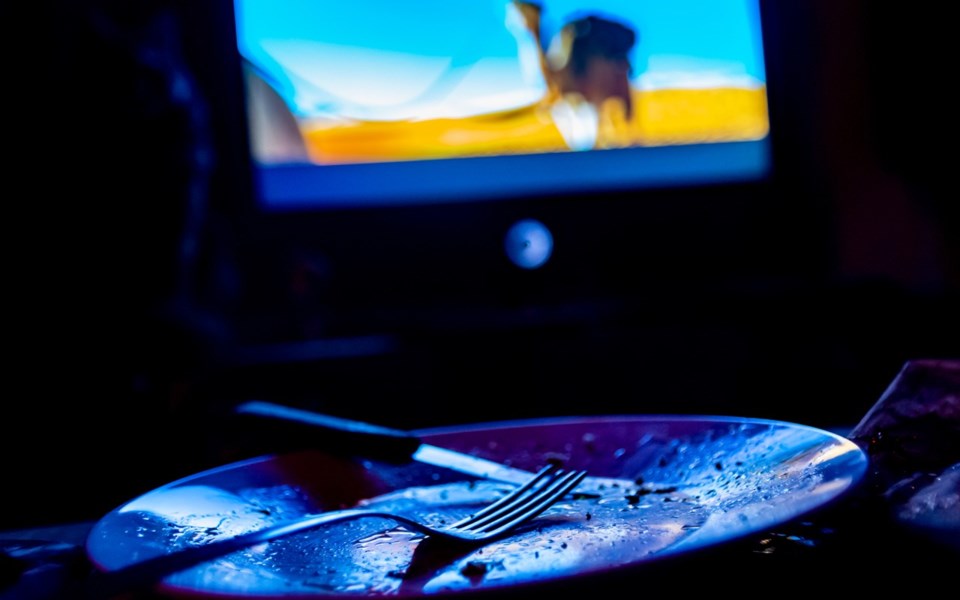Ah, the cold, dark nights creep in—earlier and earlier, lasting longer and longer. What to do, except curl up with your black mirror of choice—plasma, pod or otherwise—and watch a darn good movie. (Don't forget the popcorn.) And what with Whistler's film fest right around the corner, what more could you ask?
In the midst of the only corporate job I ever had—one with a posh corner office, the best salary ever, decent expense account and a flex four-day work week—I quit to take screenwriting at UBC. What else? Movies are the best storytellers on the planet.
I have tons of favourites I could go on about, ones that we learned about in that class and more, but given this is a food col, let's spotlight ones with such tasty food scenes they can't miss.
For an insider take, I turned to Pique's awesome film guy and original movie-maker himself, Feet Banks. Best food scenes in movies? Feet can think of more than a few...
The pie-eating-contest-gone-wrong in the 1986 film Stand by Me when Lardass pukes up five pies' worth of blueberries and makes everyone puke—that's Feet's all-time winner. Then there's the opening scene of The Big Lebowski, where Jeffrey "The Dude" Lebowski—L.A. slacker and big-time bowler—stops in the grocery store for cream for his White Russians and has to pay the 69-cent bill with a cheque. And the Big Kahuna Burger scene in Pulp Fiction, right before Samuel Jackson wastes those kids who did an end run around him and his partner in crime, John Travolta.
"Wanna bite? They're real tasty..." he tempts Travolta before the fun begins.
But the one that holds a special place in Feet's heart, and many others, is the very famous, very sweet Lady and the Tramp spaghetti scene. You know the one from Walt Disney's 1955 production, where Lady (the purebred American cocker spaniel) and Tramp (the stray mutt with attitude) are out for dinner at an Italian resto, complete with red-and-white-checkered tablecloth, drippy candle in the old Ruffino wine bottle, and a plate of spaghetti and meatballs.
Lady and Tramp each grab one end of the same piece of spaghetti, and noodle it into their mouths, getting closer and closer until their sweet little muzzles mmm-meet. Feet and his late pal, the great Chili Thom, recreated the scene in a film they made with Linzee—one of those things you never forget.
All this reminds me of a cool lecture I attended at Emily Carr University of Art and Design a few years back that also shone a new angle on food in flicks. It was by Vancouver-based Harry Killas, now an associate prof there, who shot his first film in Grade 9. He went on to make a spoof on Babette's Feast—Babette's Feet, which he shot in five days. His films have been featured at many a festival, but I don't think ever at Whistler (correct me if I'm wrong).
To his credit, Killas didn't highlight flicks where food is the central motif (like Babette's Feast or Eat, Drink, Man, Woman). Instead, he focused on scenes staged around meals and eating as part of the dramatic narrative, pointing out how tricky they are to shoot (it's not unusual to take out a wall to get a shot right), and what kind of dynamics and subtext are at play.
Meal scenes in film—and often in real life—are constructions that force people to interact in a confined space whether or not they have any relationship or sense of community. Note the keyword: "force."
Other than maybe a quick take of an iconic turkey, we never see an idealized meal itself. That would be boring. Instead, it's the interactions of people around the food that count. (See Feet's choices, above).
So it's dinner scene as social commentary, and how much the director can tease out of that. Sometimes it can be a lot, as with the crazed, dysfunctional family in Little Miss Sunshine—a suicidal gay uncle, a heroin-snorting grandpa, a Type-A hubby and, of course, little Miss Olive and her harried mom who, as always, tries to keep everyone and everything running smoothly.
Throughout cinematic history, most dinner scenes of family life, idealized or not, show images of a woman working—serving food, cooking food—which is how the bourgeois status quo is maintained. At the centre is the father, the prime recipient of all that good food and service.
In Fellini's 1974 Amarcord—a nostalgic, fantastical, quasi-autobiographical look at life in 1930s seaside Italy—the traditional dinner scene takes a bittersweet twist with a poignant portrayal of family.
When the movie was shot, the birth rate had dropped significantly in Italy, and oil and food prices had sky-rocketed. Women had flooded the workforce and the pill was popular so family values, or even the possibility of children, were declining. Amarcord's perfect family dinner scene is a slice of nostalgia served with longing.
In Meet Me in St Louis, released in 1944 at the height of U.S. involvement in the Second World War, it's a 1903 St. Louis family that's drenched in nostalgia and idealized. Here, the dinner scene represents the all-American family as the cornerstone of social order. But the scene—the entire movie—was also a dark denial of the conflict happening overseas while production was underway—a conflict where thousands of "boys next door" were being slaughtered.
As for your best picks at the film fest, or during these long, dark nights at home, please forward your favourites—food scenes or not, to edit@piquenewsmagazine.com. After all, Foodora can only deliver so much.
Glenda Bartosh is an award-winning journalist who just made some popcorn.




